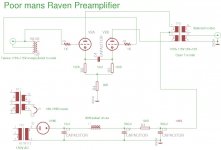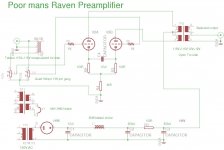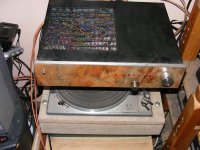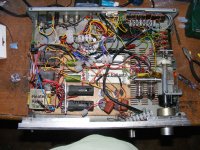Hi all,
I have been working on a version of the Raven preamplifier by Lynn Olsen. Since I couldn't afford the expense of LL1660 transformers I have substituted cheap and cheerful Toroidal power transformers for both input and output duty. I used Taleman encapsulated transformers as a center tapped choke for the input. These drive a quad heliopot (wire wound pot at 10K) which in turn drive a 5687 into the final transformer. I attempted to use the same taleman encapsulated transformers at the output - but the encapsulation increased the interwinding capacitance to unacceptable levels. I therefore substituted some open frame toroidals with a step down ratio of 115V+115V:12V+12V. These generate two separate outputs - one for my main amp and one for my active subs. So far they are working with just a 10uf cathode to cathode bypass and each cathode is biased with a 100R resistor followed by a shared 60R resistor - DC current balance is less than 0.3mA different. I will eventually add a current mirror.
Power supply is dual mono using a UY85 followed by a 10uf cap > a florescent light ballast choke > 300uf > 100R > 300uf.
Source selection is via reed relays.
So far it is running whisper quite with AC heaters (and a rats nest of interconnecting wires). Response is good to at least 20khz and down to 10hz (though I haven't measured it in detail). Comparing it to my ECL80 FVP5 SLCF clone it betters it in nearly every way. Bass is better defined, detail is better. Everything seems to have a more transparency and life. Frankly I am amazed at the difference.
Even though this is a poor mans implementation, it is still not cheap overall;
Input transformers €20
Output transformers €25
Heliopot €55
Power transformers €30
Ballasts €15
5687 €15
I had the reed relays but they would be worth about €50.00. I used caps salvaged from PC PSU. All of these components were assembled from Ebay purchases and would have been significantly more expensive bought new.
If anyone is interested I can lash up a schematic and post a photo of the build.
Shoog
I have been working on a version of the Raven preamplifier by Lynn Olsen. Since I couldn't afford the expense of LL1660 transformers I have substituted cheap and cheerful Toroidal power transformers for both input and output duty. I used Taleman encapsulated transformers as a center tapped choke for the input. These drive a quad heliopot (wire wound pot at 10K) which in turn drive a 5687 into the final transformer. I attempted to use the same taleman encapsulated transformers at the output - but the encapsulation increased the interwinding capacitance to unacceptable levels. I therefore substituted some open frame toroidals with a step down ratio of 115V+115V:12V+12V. These generate two separate outputs - one for my main amp and one for my active subs. So far they are working with just a 10uf cathode to cathode bypass and each cathode is biased with a 100R resistor followed by a shared 60R resistor - DC current balance is less than 0.3mA different. I will eventually add a current mirror.
Power supply is dual mono using a UY85 followed by a 10uf cap > a florescent light ballast choke > 300uf > 100R > 300uf.
Source selection is via reed relays.
So far it is running whisper quite with AC heaters (and a rats nest of interconnecting wires). Response is good to at least 20khz and down to 10hz (though I haven't measured it in detail). Comparing it to my ECL80 FVP5 SLCF clone it betters it in nearly every way. Bass is better defined, detail is better. Everything seems to have a more transparency and life. Frankly I am amazed at the difference.
Even though this is a poor mans implementation, it is still not cheap overall;
Input transformers €20
Output transformers €25
Heliopot €55
Power transformers €30
Ballasts €15
5687 €15
I had the reed relays but they would be worth about €50.00. I used caps salvaged from PC PSU. All of these components were assembled from Ebay purchases and would have been significantly more expensive bought new.
If anyone is interested I can lash up a schematic and post a photo of the build.
Shoog
........
If anyone is interested I can lash up a schematic and post a photo of the build.
Shoog
please do
cheapskate

Because it is operating as a center tap choke - the demands on the input transformer are relaxed. Basically I have found talemac to work excellently in this role in a number of implementations. Source impedance should be low - but I have not encountered any issues with standard CD players and other components. EI transformers will not subsistent for toroidal and open frame will always be better than encapsulated.
Something to be aware of is that the primary side of the transformer can be wired up in two directions and one will sound better than the other. This is because one end of the primary winding is closer to the core and there is higher leakage capacitance at that end.
After a few days of listening I decided to load the output secondaries with a 1K resistor to calm down the top end a fraction. My experience is that a fixed 1K load will generally improve performance.
Shoog
Something to be aware of is that the primary side of the transformer can be wired up in two directions and one will sound better than the other. This is because one end of the primary winding is closer to the core and there is higher leakage capacitance at that end.
After a few days of listening I decided to load the output secondaries with a 1K resistor to calm down the top end a fraction. My experience is that a fixed 1K load will generally improve performance.
Shoog
Tried an encapsulated Talema 15VA115+115:18+18)as output in a 6H30 parafeed preamp and it was completely useless for audio. Any theories about why capacitances are higher in those?
About input mains toroids I haven´t measured inductance but I guess reactance is not higher than 5-10k. Can check the primary inductance of the above mentioned later today. This parallelled with the pots then makes Zin acceptable but quite low.
About input mains toroids I haven´t measured inductance but I guess reactance is not higher than 5-10k. Can check the primary inductance of the above mentioned later today. This parallelled with the pots then makes Zin acceptable but quite low.
Last edited:
I was reading that air has a quarter of the dialectric figure than epoxy - and this is where I think the difference lies . Interwinding capacitance is always going to be high when using toroidals and increasing it by (potentially) a factor of 4x is going to kill the circuit. I found that response was tailing off above 10K when I attempted to use the encapsulated one on the output.
Response is acceptable down to very low frequencies. It may not have much drive into the 5687 grids - but its an easy load and seems adequate. Configured as a CTC increases overall performance by an order of magnitude.
Shoog
Response is acceptable down to very low frequencies. It may not have much drive into the 5687 grids - but its an easy load and seems adequate. Configured as a CTC increases overall performance by an order of magnitude.
Shoog
I promised a picture - though I have to say I am not proud of the look of the beast.
It just goes to show that strict adherence to star grounding (at the back where all the yellow wires go to) is more important than neat wire layout. This preamp is quiet - real quiet.
I will look for the details of the transformers used. The main power transformers are some nice little C-core models salvaged from a reel to reel tape recorder.
Shoog
It just goes to show that strict adherence to star grounding (at the back where all the yellow wires go to) is more important than neat wire layout. This preamp is quiet - real quiet.
I will look for the details of the transformers used. The main power transformers are some nice little C-core models salvaged from a reel to reel tape recorder.
Shoog
Attachments
I have no induction meter so cannot say exactly. However the amount of capacitance following them would normally fry the UY85 and they are fine. I have ran a similar power supply on my FVP5 clone for well over two years and have encountered no issues with arcing rectifiers. The caps are doing most of the heavy lifting here - but the use of any type of choke brings considerable benefits in terms of line hash suppression.
I have heard of them been used as plate chokes, and I have equally heard people say that they will have next to no inductance with DC present.
Shoog
I have heard of them been used as plate chokes, and I have equally heard people say that they will have next to no inductance with DC present.
Shoog
The intention is to eventually replace the 60R resistor (common) with a current mirror and two 100R resistors. This will raise the cathode resistance considerably (I believe). This is essential as even though current balance excellent at the moment - it will drift over time and start saturating the OT. The 10uf is a full bypass from cathode to cathode making it an effective LTP output stage. I may raise this to 20uf - but the calculated increase in bass extension appears to be marginal until you reach many 100's of uf.
So the intention is to allow for different bias arrangements whilst maintaining full differential LTP behaviour.
Shoog
So the intention is to allow for different bias arrangements whilst maintaining full differential LTP behaviour.
Shoog
- Status
- This old topic is closed. If you want to reopen this topic, contact a moderator using the "Report Post" button.
- Home
- Amplifiers
- Tubes / Valves
- My poor man version of the Raven Preamplifier.



